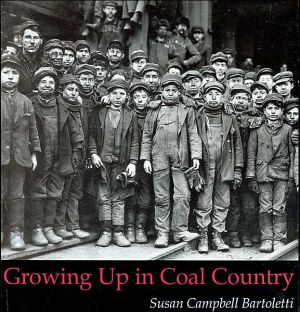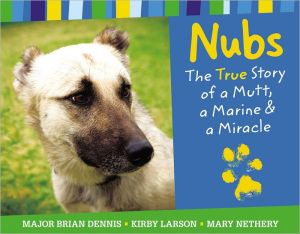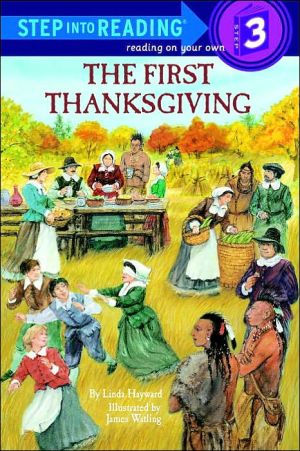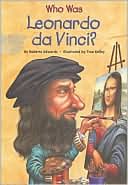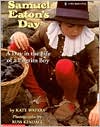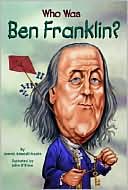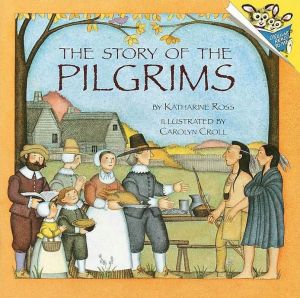Growing Up in Coal Country
Through interviews, newspaper accounts, and other original sources, Bartoletti pieced together a picture of life in the Pennsylvania coal mines at the turn of the century. "With compelling black-and-white photographs of children . . . this handsome, spacious photo-essay will draw browsers as well as students doing research on labor and immigrant history." -- Booklist, starred review\ Author Biography: A former 8th-grade English teacher, Susan Campbell Bartoletti writes fiction and nonfiction...
Search in google:
Inspired by her in-laws' recollections of working in coal country, Susan Campbell Bartoletti has gathered the voices of men, women, and children who immigrated to and worked in northeastern Pennsylvania at the turn of the century. The story that emerges is not just a story of long hours, little pay, and hazardous working conditions; it is also the uniquely American story of immigrant families working together to make a new life for themselves. It is a story of hardship and sacrifice, yet also of triumph and the fulfillment of hopes and dreams.Children's LiteratureThis is a fascinating history of the anthracite coal industry in Pennsylvania from the point of view of child laborers. How boys grew from "breakers" (who sorted the coal), to "nippers" (keepers of the underground gates), to "spraggers" (human brakes for careening coal cars), to mule drivers, and finally to full-fledged miners is worth the price of admission in itself. But Bartoletti's book goes way beyond this to describe the company towns, the labor disputes, and the ethnic animosity. She recreates a way of life. Wonderfully evocative black and white photos and selected excerpts from oral histories of survivors complete the picture. This book should make any frustrated schoolboy thank his lucky stars for the child labor laws that keep him in school-and not down in the mines.
\ Children's Literature\ - Kathleen Karr\ This is a fascinating history of the anthracite coal industry in Pennsylvania from the point of view of child laborers. How boys grew from "breakers" (who sorted the coal), to "nippers" (keepers of the underground gates), to "spraggers" (human brakes for careening coal cars), to mule drivers, and finally to full-fledged miners is worth the price of admission in itself. But Bartoletti's book goes way beyond this to describe the company towns, the labor disputes, and the ethnic animosity. She recreates a way of life. Wonderfully evocative black and white photos and selected excerpts from oral histories of survivors complete the picture. This book should make any frustrated schoolboy thank his lucky stars for the child labor laws that keep him in school-and not down in the mines.\ \ \ \ \ School Library JournalGr 5-8-Bartoletti uses oral history, archival documents, and an abundance of black-and-white photographs to make turn-of-the-century mining life a surprisingly compelling subject for today's young people. Zooming in on northeastern Pennsylvania in general, and the perspective of children in particular, she writes of the desperate working conditions, the deplorable squalor found in the "patch villages," and the ever-present dangers of the occupation. Stories of breaker-boy pranks and the roles of the animals at work bring some comic relief, but even they point out the enormous hardships suffered before there were effective unions and child-labor laws. The words and work of children are weighted equally with the efforts of the Molly McGuires, Mother Jones, and other adult players. Captioned, black-and-white photographs, with attributions, appear on almost every page, allowing the images to play a powerful role in the gritty story. The bibliography reveals the depth of Bartoletti's research. An introduction conveys her motivation (fascination with family stories), while a brief conclusion touches upon the region in the post-World War I era. For a first-rate, accessible study of a time and place that played an important role in American economic and social history, look no further.-Wendy Lukehart, Dauphin County Library, Harrisburg, PA\ \ \ From the PublisherBartoletti has written a concise, thoroughly researched account of the often grim working and living conditions in Pennsylvania coal towns. An accessible writing style, as well as the abundance of stimulating information, makes for an engrossing historical account. Quotes from personal interviews with miners, as well as taped interviews and transcripts, provide a refreshing first person frame of reference. Horn Book\ With compelling black-and-white photographs of children at work in the coal mines of northeastern Pennsylvania about 100 years ago, this handsome, spacious photo-essay will draw browsers as well as students doing research on labor and immigrant history. The story of these boys' lives are a part of Russell Freedman's general overview Kids at Work (1994) and of Betsy Harvey Kraft's biography Mother Jones (1995); but there's a wealth of personal detail and family story here that focuses on what it was like in the mines and in the homes and communities of these working children. Lewis Hines' famous pictures will grab readers, and Bartoletti has also gathered dozens of archival photos and heartbreaking oral histories. They show what it was like for eight-year-old breaker boys sorting coal surrounded by deafening noise and black clouds of dust, steam, and smoke; what it was like to be a mule driver underground; what it meant to be a spragger, a butty, a nipper. Drawing on personal interviews, archival tapes and transcripts, and a wide range of historical resources, Bartoletti finds heartfelt memories of long hours, hard labor, and extremely dangerous working conditions, as well as lighter accounts of spirited rebellion, mischief, and bonding. The immigrant experience is an integral part of this "coal culture": the strength of ethnic groups and the prejudice against them, and their banding together to form strong labor unions. As with most fine juvenile nonfiction, this will also have great appeal for adults.\ Booklist, ALA, Starred Review\ Bartoletti uses oral history, archival documents, and an abundance of black-and-white photographs to make turn-of-the-century mining life a surprisingly compelling subject for today's young people.\ School Library Journal, Starred\ \ \
